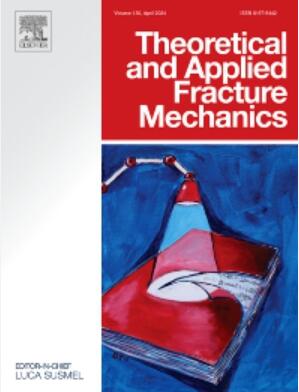研究了冻融循环对冲击载荷作用下红砂岩动态断裂特性的影响
IF 5.6
2区 工程技术
Q1 ENGINEERING, MECHANICAL
引用次数: 0
摘要
了解冻融循环作用下岩石的动态断裂行为对于保证寒区建筑工程和岩石工程活动的安全和稳定至关重要。采用分离式霍普金森压力杆(SHPB)和核磁共振技术(NMR)方法,揭示了FTCs影响下砂岩的动态裂缝和孔隙度特征。在不同冲击压力下进行了动态断裂试验,探讨了加载速率(K)对动态断裂特性的影响。结果表明:平均动态断裂韧性(KIC(d))与FTCs数量呈非线性下降趋势;随着FTCs数量的增加,KIC(d)的平均值降低,并且这种损失在每个周期后变得更加明显。其中,KIC(d)由0个周期急剧下降至20个周期,然后稳定在40个周期。随着公平交易中心的数目接近80个,KIC(d)已大幅减少。KIC(d)随加载速率(K)的增加而逐渐增大。通过核磁共振分析发现,岩石样品的总孔隙度与FTCs数量之间存在相关性,表明孔隙度随周期的增加而增加。微孔的数量随FTCs的变化而波动,没有明显的趋势。而在整个冻融过程中,大孔隙不断增加,表明岩石微观结构的破坏主要是由大孔隙度的增加引起的。在孔隙度变化规律的基础上,引入损伤因子(Dft),论证了FTCs作用下砂岩的损伤特征。相关性分析表明,在一定的加载速率(K)范围内,KIC(d)随Dft的增大呈指数下降,具有良好的相关性。本研究结果将有助于制定旨在提高寒冷气候条件下岩质边坡工程安全性和稳定性的指导方针。本文章由计算机程序翻译,如有差异,请以英文原文为准。
Investigating the impact of freezing and thawing cycles on the dynamic fracture properties of red sandstone subjected to impact loading
Comprehending the dynamic fracture behaviour of rocks exposed to freeze–thaw cycles (FTCs) is essential for warranting the safety and stability of construction projects and rock engineering activities in frigid regions. In this study, the split Hopkinson pressure bar (SHPB) and nuclear magnetic resonance techniques (NMR) methods are adapted to reveal the dynamic fracture and porosity characteristics of sandstone influenced by FTCs. The dynamic fracture tests were conducted under different impact pressures and the effect of loading rate on dynamic fracture characteristics is elucidated. The results revealed that there is a non-linearly declining trend between the average dynamic fracture toughness (KIC(d)) and the number of FTCs. As the number of FTCs increases, the mean values of KIC(d) decrease, and this loss after each cycle becomes more pronounced. Amongst the FTCs, the KIC(d) decreased drastically from 0 to 20 FTCs, then stabilized at 40 cycles. As the number of FTCs approaches 80, the KIC(d) has significantly decreased. The KIC(d) demonstrated a gradual increase corresponding to the loading rate during different FTCs. The analysis conducted through NMR revealed a correlation between the total porosity of rock specimens and the number of FTCs, indicating an increase in porosity with each cycle. The number of micropores fluctuates with FTCs, showing no obvious trend. However, macropores consistently increase throughout the freezing and thawing process, indicating that the rock’s microstructural impairment primarily arises from the increase in macropore porosity. Based on the variation law in porosity, the damage characteristics of sandstone under FTCs are demonstrated by introducing a damage factor (Dft). It has been unveiled from the correlation analysis, that under a specific loading rate range, the KIC(d) exponentially declines with an increase of Dft revealing a good correlation. The results of this research will contribute to the formulation of guidelines aimed at enhancing the safety and stability of rock slope engineering in cold climates.
求助全文
通过发布文献求助,成功后即可免费获取论文全文。
去求助
来源期刊

Theoretical and Applied Fracture Mechanics
工程技术-工程:机械
CiteScore
8.40
自引率
18.90%
发文量
435
审稿时长
37 days
期刊介绍:
Theoretical and Applied Fracture Mechanics'' aims & scopes have been re-designed to cover both the theoretical, applied, and numerical aspects associated with those cracking related phenomena taking place, at a micro-, meso-, and macroscopic level, in materials/components/structures of any kind.
The journal aims to cover the cracking/mechanical behaviour of materials/components/structures in those situations involving both time-independent and time-dependent system of external forces/moments (such as, for instance, quasi-static, impulsive, impact, blasting, creep, contact, and fatigue loading). Since, under the above circumstances, the mechanical behaviour of cracked materials/components/structures is also affected by the environmental conditions, the journal would consider also those theoretical/experimental research works investigating the effect of external variables such as, for instance, the effect of corrosive environments as well as of high/low-temperature.
 求助内容:
求助内容: 应助结果提醒方式:
应助结果提醒方式:


